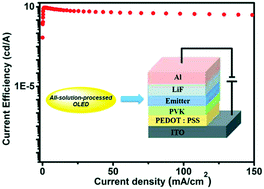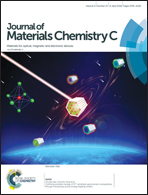High-performance red electrophosphorescent devices based on all-solution-processed hydrogen-bonded supramolecular material†
Abstract
An oligoamide strand bearing a guest phosphorescent unit, named 4HB-Irpiq, was designed and synthesized. The guest hydrogen-bonded strand 4HB-Irpiq could self-assemble via hydrogen-bonding interactions with the host hydrogen-bonded strand 4HB-CzNI into a hydrogen-bonded supramolecule, named 4HB-Irpiq-CzNI. In comparison with physical blends of the guest counterpart Irpiq with host small molecule CzNI, 4HB-Irpiq-CzNI shows a more efficient energy transfer process between host and guest in both dilute solution and doped film state, which could be attributed to the shortened spatial distance between the host and guest units. Moreover, compared with Irpiq, 4HB-Irpiq-CzNI shows a higher photoluminescence quantum yield in the neat-film state, indicating that 4HB-Irpiq-CzNI could be better at alleviating concentration quenching. As a consequence, a phosphorescent organic light-emitting diode with 4HB-Irpiq-CzNI and Irpiq as the light-emitting dopant has been fabricated based on all-solution-processing. The results indicate that OLEDs with 4HB-Irpiq-CzNI show dramatically improved performance over the counterpart Irpiq: with a lower turn-on voltage (6.0 vs. 7.6 V), higher maximum luminance (6446 vs. 2543 cd m−2) and current efficiency (7.0 vs. 4.3 cd A−1) as well as a lower efficiency roll-off. The hydrogen-bonded supramolecular 4HB-Irpiq-CzNI material shows one of the best performances among all-solution-processed red PhOLEDs.



 Please wait while we load your content...
Please wait while we load your content...